Customer Service in AIRCANADA'S NEW BOOKING SYSTEM
VerifiedAdded on 2022/08/12
|17
|3867
|176
AI Summary
AIR CANADA’S NEW BOOKING SYSTEM ANALYSIS 2 Running Head: AIR CANADA’S NEW BOOKING SYSTEM ANALYSIS 1 CASE ANALYSIS: AIR CANADA’S NEW BOOKING SYSTEM - No customer complaint dealability to the entire business. Lack of the required change management led to ineffective management - Longer wait time: The new customer support system that processes customer calls is finally directed to handle a sufficiently large number of calls at a time to service customers.
Contribute Materials
Your contribution can guide someone’s learning journey. Share your
documents today.
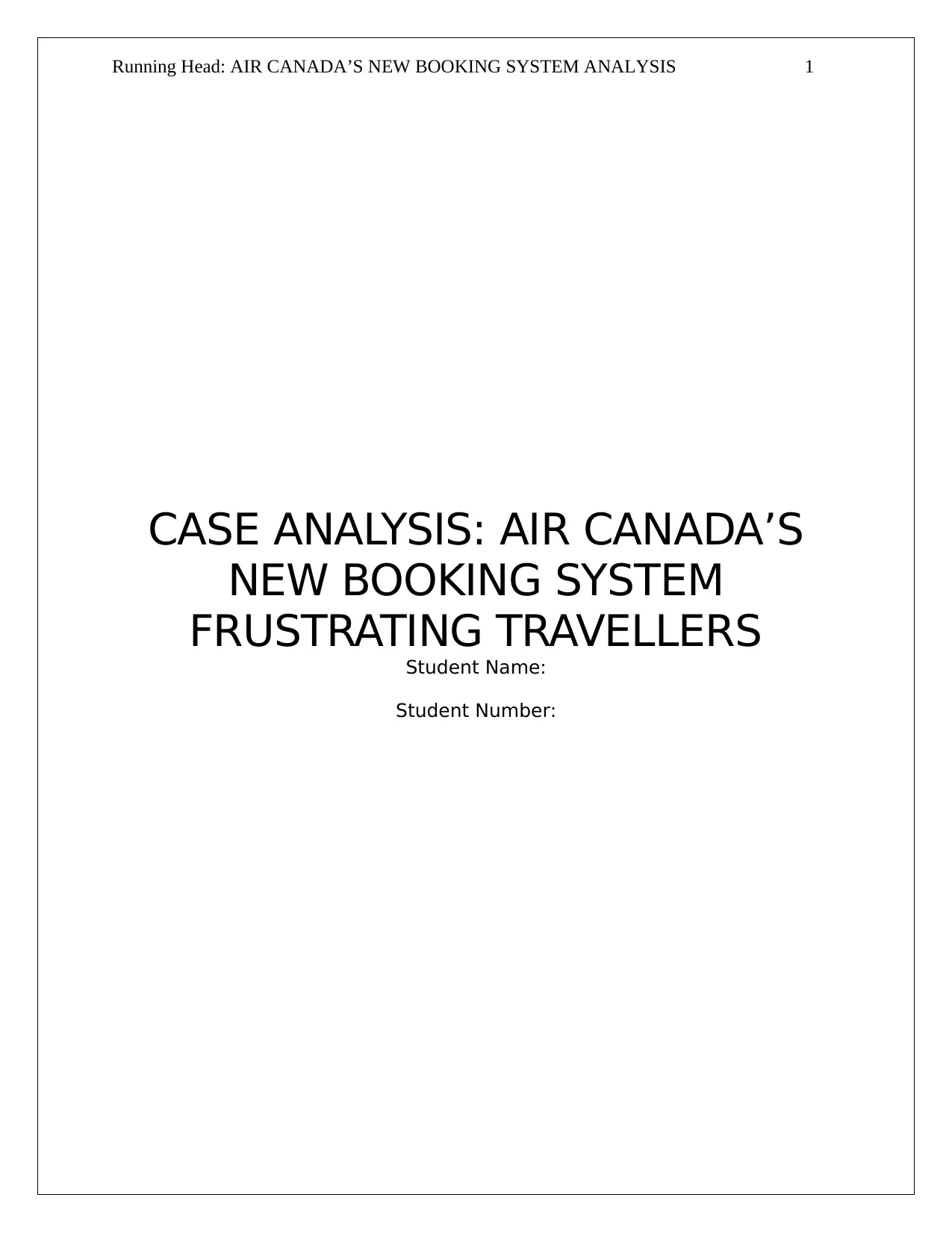
Running Head: AIR CANADA’S NEW BOOKING SYSTEM ANALYSIS 1
CASE ANALYSIS: AIR CANADA’S
NEW BOOKING SYSTEM
FRUSTRATING TRAVELLERS
Student Name:
Student Number:
CASE ANALYSIS: AIR CANADA’S
NEW BOOKING SYSTEM
FRUSTRATING TRAVELLERS
Student Name:
Student Number:
Secure Best Marks with AI Grader
Need help grading? Try our AI Grader for instant feedback on your assignments.
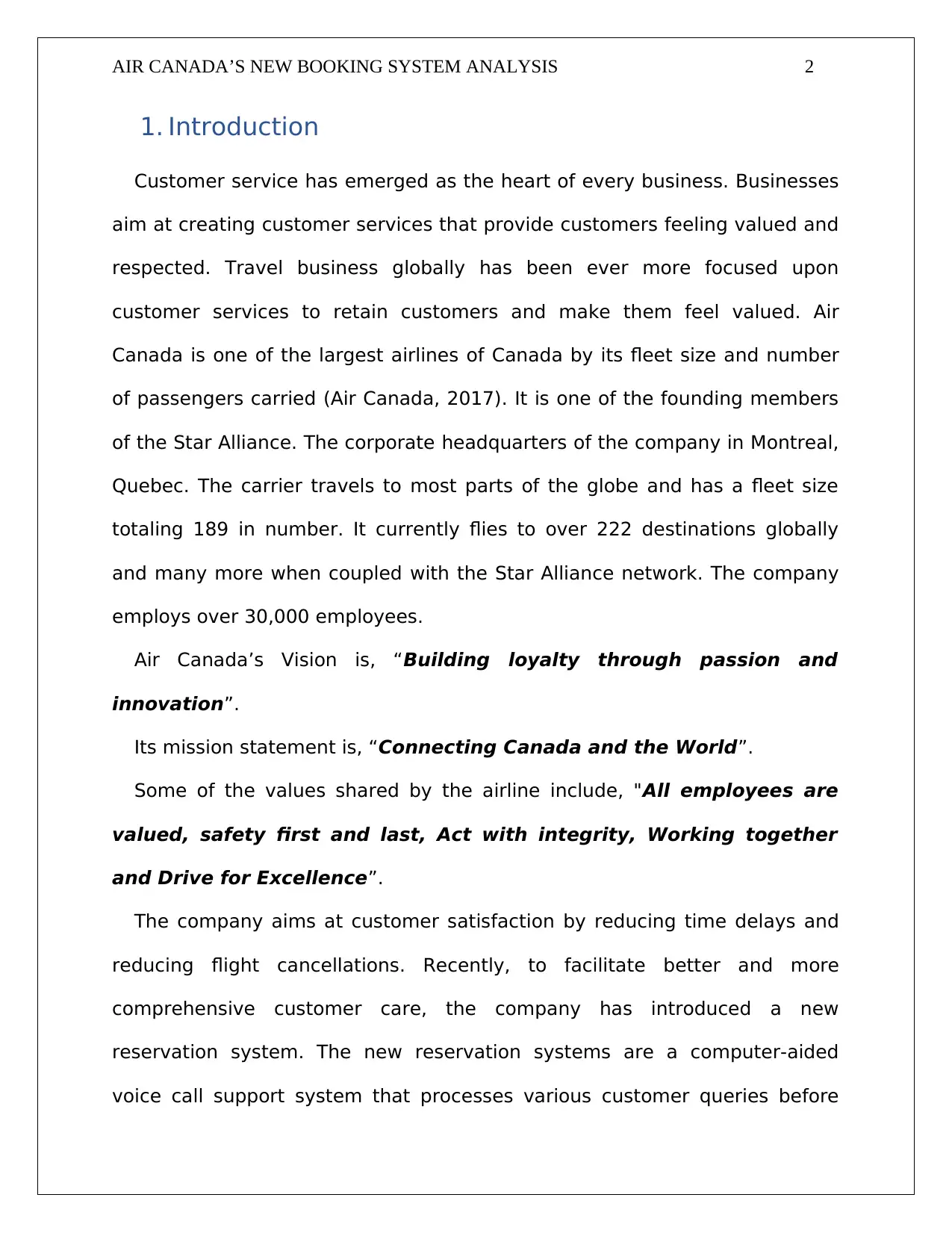
AIR CANADA’S NEW BOOKING SYSTEM ANALYSIS 2
1. Introduction
Customer service has emerged as the heart of every business. Businesses
aim at creating customer services that provide customers feeling valued and
respected. Travel business globally has been ever more focused upon
customer services to retain customers and make them feel valued. Air
Canada is one of the largest airlines of Canada by its fleet size and number
of passengers carried (Air Canada, 2017). It is one of the founding members
of the Star Alliance. The corporate headquarters of the company in Montreal,
Quebec. The carrier travels to most parts of the globe and has a fleet size
totaling 189 in number. It currently flies to over 222 destinations globally
and many more when coupled with the Star Alliance network. The company
employs over 30,000 employees.
Air Canada’s Vision is, “Building loyalty through passion and
innovation”.
Its mission statement is, “Connecting Canada and the World”.
Some of the values shared by the airline include, "All employees are
valued, safety first and last, Act with integrity, Working together
and Drive for Excellence”.
The company aims at customer satisfaction by reducing time delays and
reducing flight cancellations. Recently, to facilitate better and more
comprehensive customer care, the company has introduced a new
reservation system. The new reservation systems are a computer-aided
voice call support system that processes various customer queries before
1. Introduction
Customer service has emerged as the heart of every business. Businesses
aim at creating customer services that provide customers feeling valued and
respected. Travel business globally has been ever more focused upon
customer services to retain customers and make them feel valued. Air
Canada is one of the largest airlines of Canada by its fleet size and number
of passengers carried (Air Canada, 2017). It is one of the founding members
of the Star Alliance. The corporate headquarters of the company in Montreal,
Quebec. The carrier travels to most parts of the globe and has a fleet size
totaling 189 in number. It currently flies to over 222 destinations globally
and many more when coupled with the Star Alliance network. The company
employs over 30,000 employees.
Air Canada’s Vision is, “Building loyalty through passion and
innovation”.
Its mission statement is, “Connecting Canada and the World”.
Some of the values shared by the airline include, "All employees are
valued, safety first and last, Act with integrity, Working together
and Drive for Excellence”.
The company aims at customer satisfaction by reducing time delays and
reducing flight cancellations. Recently, to facilitate better and more
comprehensive customer care, the company has introduced a new
reservation system. The new reservation systems are a computer-aided
voice call support system that processes various customer queries before
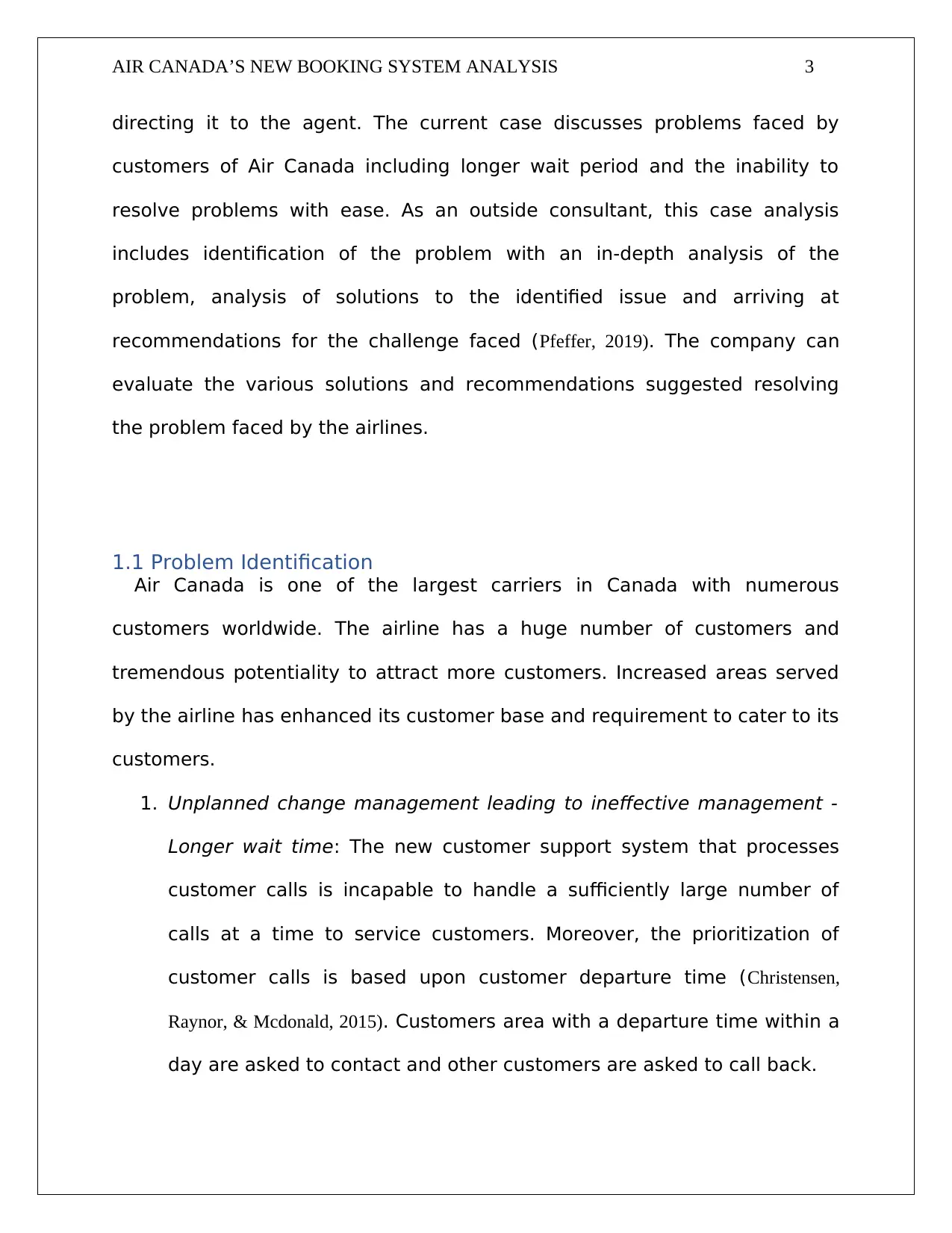
AIR CANADA’S NEW BOOKING SYSTEM ANALYSIS 3
directing it to the agent. The current case discusses problems faced by
customers of Air Canada including longer wait period and the inability to
resolve problems with ease. As an outside consultant, this case analysis
includes identification of the problem with an in-depth analysis of the
problem, analysis of solutions to the identified issue and arriving at
recommendations for the challenge faced (Pfeffer, 2019). The company can
evaluate the various solutions and recommendations suggested resolving
the problem faced by the airlines.
1.1 Problem Identification
Air Canada is one of the largest carriers in Canada with numerous
customers worldwide. The airline has a huge number of customers and
tremendous potentiality to attract more customers. Increased areas served
by the airline has enhanced its customer base and requirement to cater to its
customers.
1. Unplanned change management leading to ineffective management -
Longer wait time: The new customer support system that processes
customer calls is incapable to handle a sufficiently large number of
calls at a time to service customers. Moreover, the prioritization of
customer calls is based upon customer departure time (Christensen,
Raynor, & Mcdonald, 2015). Customers area with a departure time within a
day are asked to contact and other customers are asked to call back.
directing it to the agent. The current case discusses problems faced by
customers of Air Canada including longer wait period and the inability to
resolve problems with ease. As an outside consultant, this case analysis
includes identification of the problem with an in-depth analysis of the
problem, analysis of solutions to the identified issue and arriving at
recommendations for the challenge faced (Pfeffer, 2019). The company can
evaluate the various solutions and recommendations suggested resolving
the problem faced by the airlines.
1.1 Problem Identification
Air Canada is one of the largest carriers in Canada with numerous
customers worldwide. The airline has a huge number of customers and
tremendous potentiality to attract more customers. Increased areas served
by the airline has enhanced its customer base and requirement to cater to its
customers.
1. Unplanned change management leading to ineffective management -
Longer wait time: The new customer support system that processes
customer calls is incapable to handle a sufficiently large number of
calls at a time to service customers. Moreover, the prioritization of
customer calls is based upon customer departure time (Christensen,
Raynor, & Mcdonald, 2015). Customers area with a departure time within a
day are asked to contact and other customers are asked to call back.
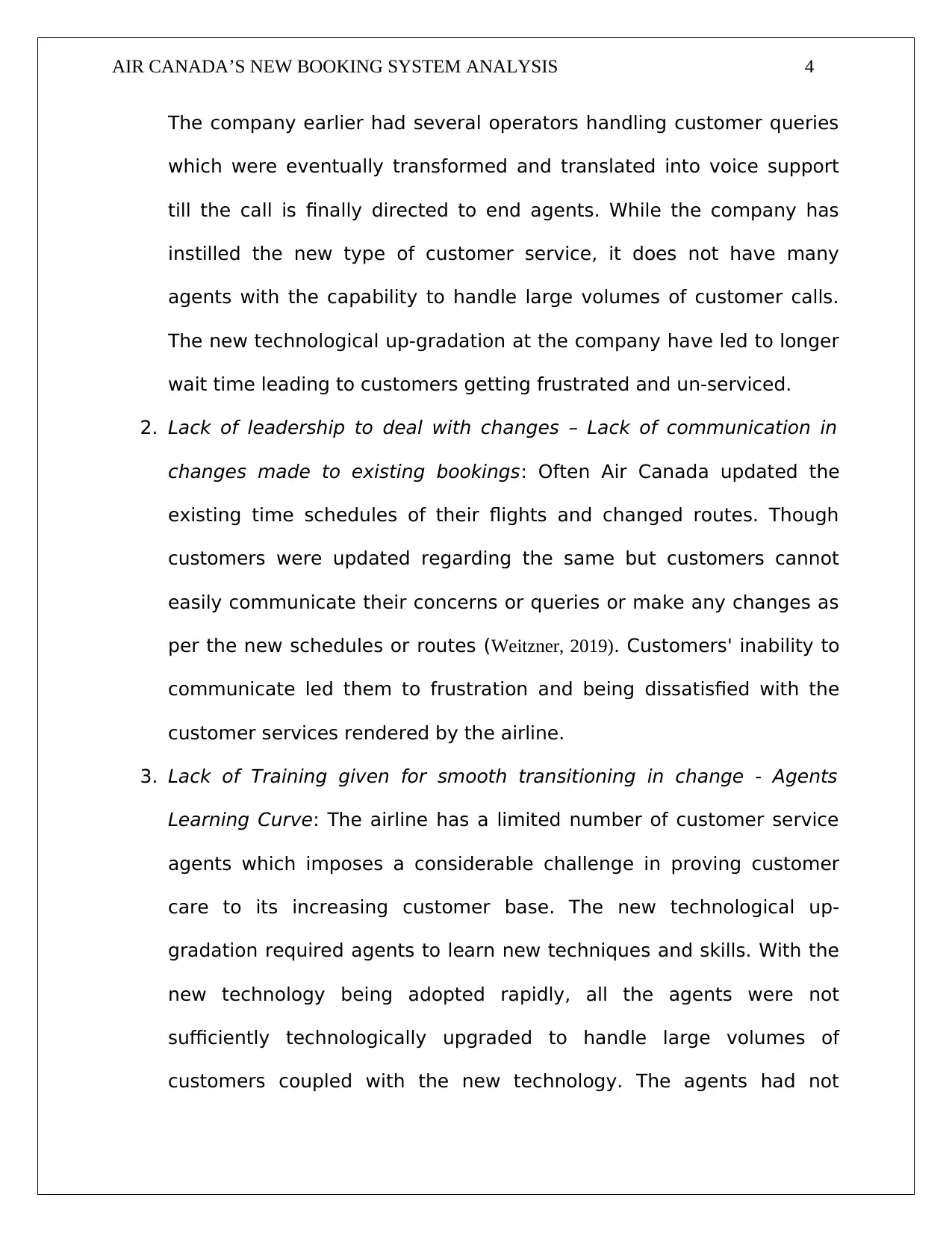
AIR CANADA’S NEW BOOKING SYSTEM ANALYSIS 4
The company earlier had several operators handling customer queries
which were eventually transformed and translated into voice support
till the call is finally directed to end agents. While the company has
instilled the new type of customer service, it does not have many
agents with the capability to handle large volumes of customer calls.
The new technological up-gradation at the company have led to longer
wait time leading to customers getting frustrated and un-serviced.
2. Lack of leadership to deal with changes – Lack of communication in
changes made to existing bookings: Often Air Canada updated the
existing time schedules of their flights and changed routes. Though
customers were updated regarding the same but customers cannot
easily communicate their concerns or queries or make any changes as
per the new schedules or routes (Weitzner, 2019). Customers' inability to
communicate led them to frustration and being dissatisfied with the
customer services rendered by the airline.
3. Lack of Training given for smooth transitioning in change - Agents
Learning Curve: The airline has a limited number of customer service
agents which imposes a considerable challenge in proving customer
care to its increasing customer base. The new technological up-
gradation required agents to learn new techniques and skills. With the
new technology being adopted rapidly, all the agents were not
sufficiently technologically upgraded to handle large volumes of
customers coupled with the new technology. The agents had not
The company earlier had several operators handling customer queries
which were eventually transformed and translated into voice support
till the call is finally directed to end agents. While the company has
instilled the new type of customer service, it does not have many
agents with the capability to handle large volumes of customer calls.
The new technological up-gradation at the company have led to longer
wait time leading to customers getting frustrated and un-serviced.
2. Lack of leadership to deal with changes – Lack of communication in
changes made to existing bookings: Often Air Canada updated the
existing time schedules of their flights and changed routes. Though
customers were updated regarding the same but customers cannot
easily communicate their concerns or queries or make any changes as
per the new schedules or routes (Weitzner, 2019). Customers' inability to
communicate led them to frustration and being dissatisfied with the
customer services rendered by the airline.
3. Lack of Training given for smooth transitioning in change - Agents
Learning Curve: The airline has a limited number of customer service
agents which imposes a considerable challenge in proving customer
care to its increasing customer base. The new technological up-
gradation required agents to learn new techniques and skills. With the
new technology being adopted rapidly, all the agents were not
sufficiently technologically upgraded to handle large volumes of
customers coupled with the new technology. The agents had not
Secure Best Marks with AI Grader
Need help grading? Try our AI Grader for instant feedback on your assignments.
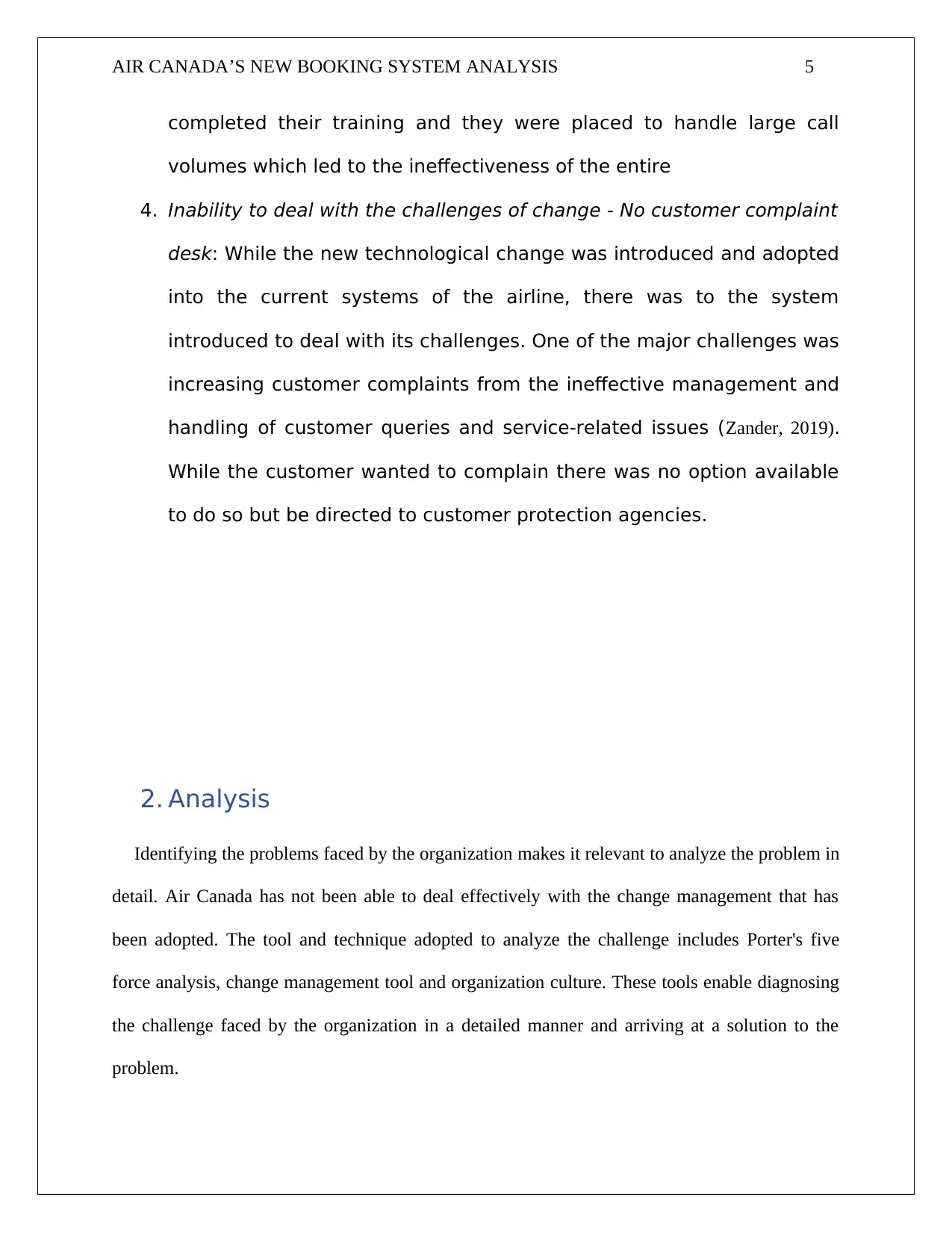
AIR CANADA’S NEW BOOKING SYSTEM ANALYSIS 5
completed their training and they were placed to handle large call
volumes which led to the ineffectiveness of the entire
4. Inability to deal with the challenges of change - No customer complaint
desk: While the new technological change was introduced and adopted
into the current systems of the airline, there was to the system
introduced to deal with its challenges. One of the major challenges was
increasing customer complaints from the ineffective management and
handling of customer queries and service-related issues (Zander, 2019).
While the customer wanted to complain there was no option available
to do so but be directed to customer protection agencies.
2. Analysis
Identifying the problems faced by the organization makes it relevant to analyze the problem in
detail. Air Canada has not been able to deal effectively with the change management that has
been adopted. The tool and technique adopted to analyze the challenge includes Porter's five
force analysis, change management tool and organization culture. These tools enable diagnosing
the challenge faced by the organization in a detailed manner and arriving at a solution to the
problem.
completed their training and they were placed to handle large call
volumes which led to the ineffectiveness of the entire
4. Inability to deal with the challenges of change - No customer complaint
desk: While the new technological change was introduced and adopted
into the current systems of the airline, there was to the system
introduced to deal with its challenges. One of the major challenges was
increasing customer complaints from the ineffective management and
handling of customer queries and service-related issues (Zander, 2019).
While the customer wanted to complain there was no option available
to do so but be directed to customer protection agencies.
2. Analysis
Identifying the problems faced by the organization makes it relevant to analyze the problem in
detail. Air Canada has not been able to deal effectively with the change management that has
been adopted. The tool and technique adopted to analyze the challenge includes Porter's five
force analysis, change management tool and organization culture. These tools enable diagnosing
the challenge faced by the organization in a detailed manner and arriving at a solution to the
problem.
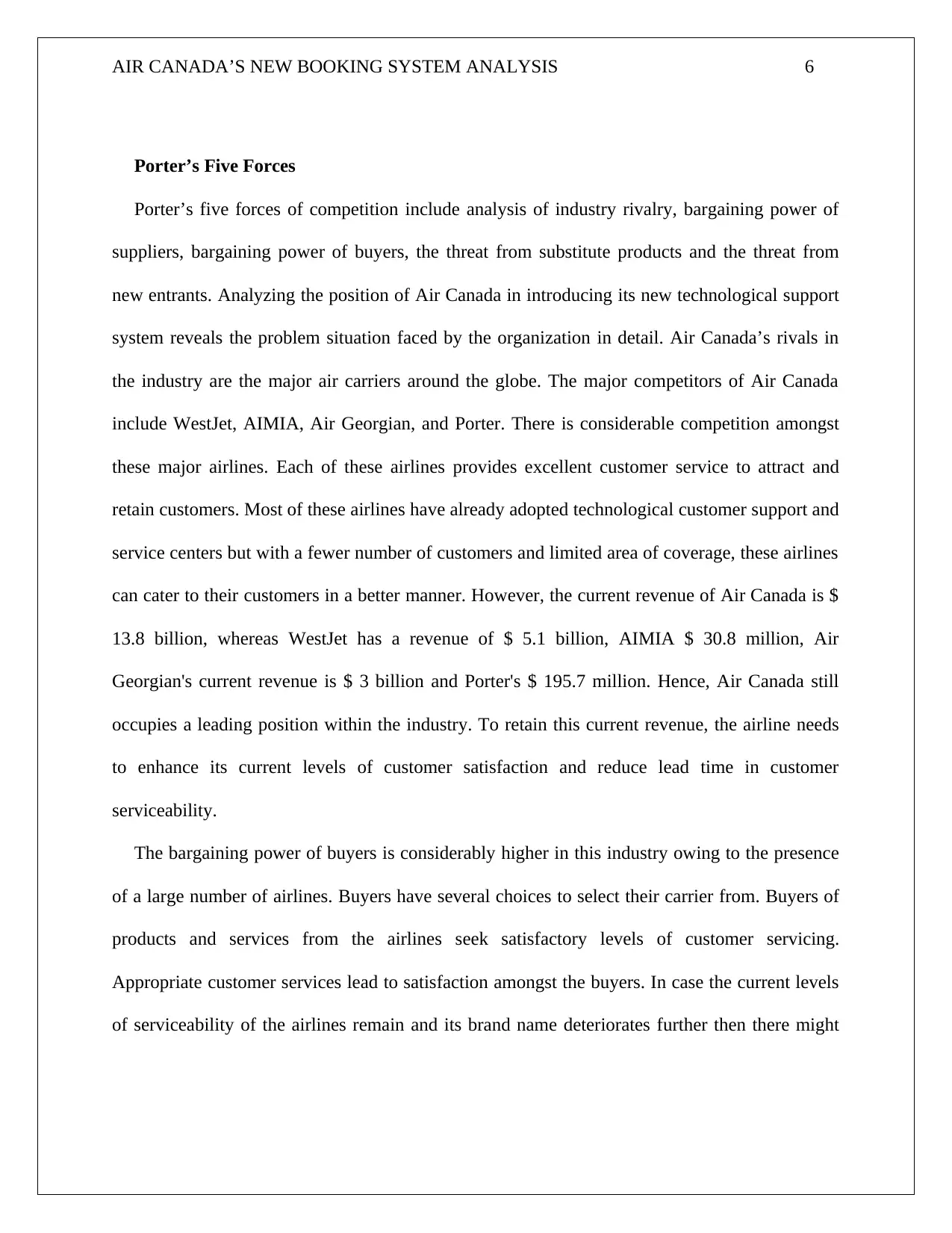
AIR CANADA’S NEW BOOKING SYSTEM ANALYSIS 6
Porter’s Five Forces
Porter’s five forces of competition include analysis of industry rivalry, bargaining power of
suppliers, bargaining power of buyers, the threat from substitute products and the threat from
new entrants. Analyzing the position of Air Canada in introducing its new technological support
system reveals the problem situation faced by the organization in detail. Air Canada’s rivals in
the industry are the major air carriers around the globe. The major competitors of Air Canada
include WestJet, AIMIA, Air Georgian, and Porter. There is considerable competition amongst
these major airlines. Each of these airlines provides excellent customer service to attract and
retain customers. Most of these airlines have already adopted technological customer support and
service centers but with a fewer number of customers and limited area of coverage, these airlines
can cater to their customers in a better manner. However, the current revenue of Air Canada is $
13.8 billion, whereas WestJet has a revenue of $ 5.1 billion, AIMIA $ 30.8 million, Air
Georgian's current revenue is $ 3 billion and Porter's $ 195.7 million. Hence, Air Canada still
occupies a leading position within the industry. To retain this current revenue, the airline needs
to enhance its current levels of customer satisfaction and reduce lead time in customer
serviceability.
The bargaining power of buyers is considerably higher in this industry owing to the presence
of a large number of airlines. Buyers have several choices to select their carrier from. Buyers of
products and services from the airlines seek satisfactory levels of customer servicing.
Appropriate customer services lead to satisfaction amongst the buyers. In case the current levels
of serviceability of the airlines remain and its brand name deteriorates further then there might
Porter’s Five Forces
Porter’s five forces of competition include analysis of industry rivalry, bargaining power of
suppliers, bargaining power of buyers, the threat from substitute products and the threat from
new entrants. Analyzing the position of Air Canada in introducing its new technological support
system reveals the problem situation faced by the organization in detail. Air Canada’s rivals in
the industry are the major air carriers around the globe. The major competitors of Air Canada
include WestJet, AIMIA, Air Georgian, and Porter. There is considerable competition amongst
these major airlines. Each of these airlines provides excellent customer service to attract and
retain customers. Most of these airlines have already adopted technological customer support and
service centers but with a fewer number of customers and limited area of coverage, these airlines
can cater to their customers in a better manner. However, the current revenue of Air Canada is $
13.8 billion, whereas WestJet has a revenue of $ 5.1 billion, AIMIA $ 30.8 million, Air
Georgian's current revenue is $ 3 billion and Porter's $ 195.7 million. Hence, Air Canada still
occupies a leading position within the industry. To retain this current revenue, the airline needs
to enhance its current levels of customer satisfaction and reduce lead time in customer
serviceability.
The bargaining power of buyers is considerably higher in this industry owing to the presence
of a large number of airlines. Buyers have several choices to select their carrier from. Buyers of
products and services from the airlines seek satisfactory levels of customer servicing.
Appropriate customer services lead to satisfaction amongst the buyers. In case the current levels
of serviceability of the airlines remain and its brand name deteriorates further then there might
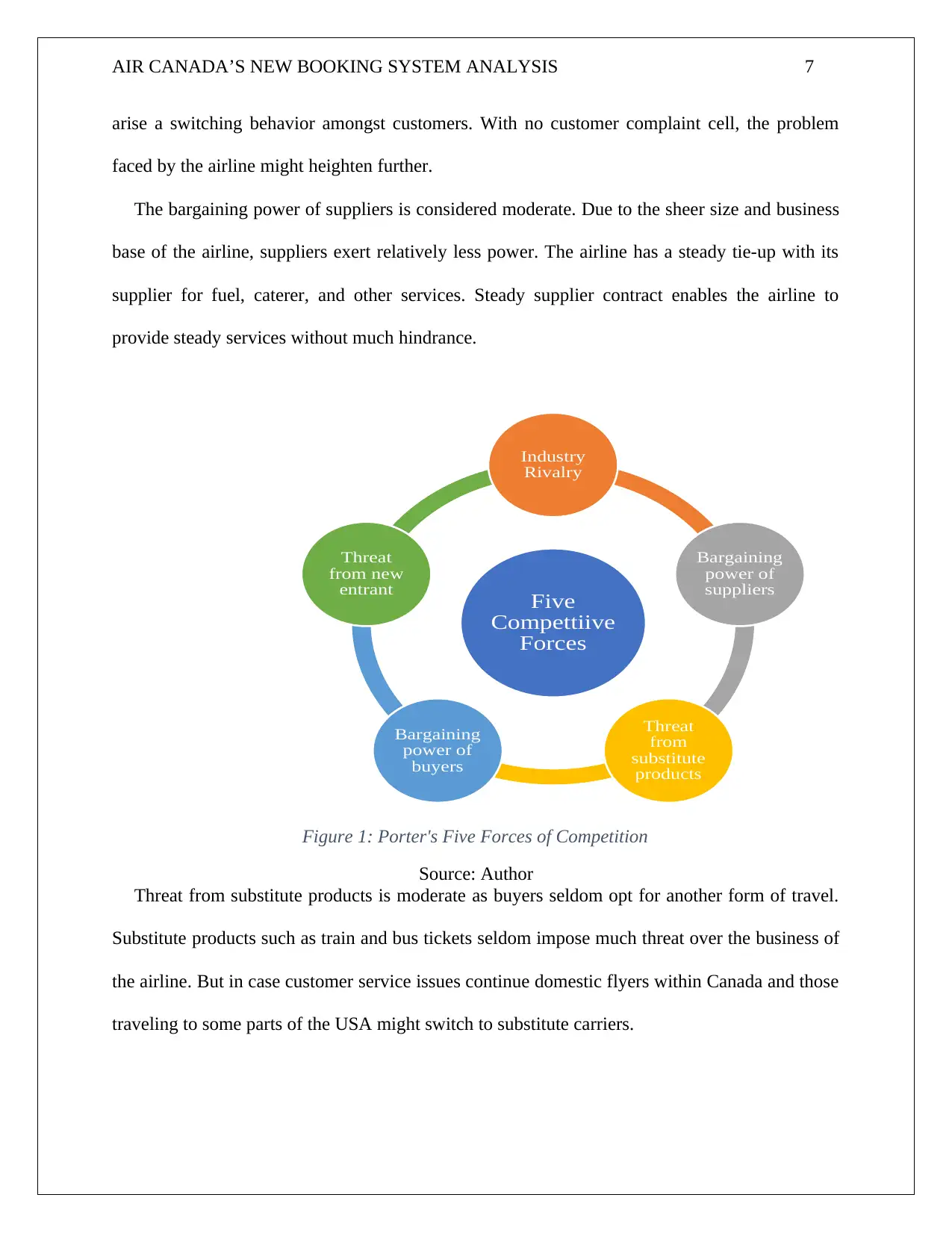
AIR CANADA’S NEW BOOKING SYSTEM ANALYSIS 7
arise a switching behavior amongst customers. With no customer complaint cell, the problem
faced by the airline might heighten further.
The bargaining power of suppliers is considered moderate. Due to the sheer size and business
base of the airline, suppliers exert relatively less power. The airline has a steady tie-up with its
supplier for fuel, caterer, and other services. Steady supplier contract enables the airline to
provide steady services without much hindrance.
Figure 1: Porter's Five Forces of Competition
Source: Author
Threat from substitute products is moderate as buyers seldom opt for another form of travel.
Substitute products such as train and bus tickets seldom impose much threat over the business of
the airline. But in case customer service issues continue domestic flyers within Canada and those
traveling to some parts of the USA might switch to substitute carriers.
Five
Compettiive
Forces
Industry
Rivalry
Bargaining
power of
suppliers
Threat
from
substitute
products
Bargaining
power of
buyers
Threat
from new
entrant
arise a switching behavior amongst customers. With no customer complaint cell, the problem
faced by the airline might heighten further.
The bargaining power of suppliers is considered moderate. Due to the sheer size and business
base of the airline, suppliers exert relatively less power. The airline has a steady tie-up with its
supplier for fuel, caterer, and other services. Steady supplier contract enables the airline to
provide steady services without much hindrance.
Figure 1: Porter's Five Forces of Competition
Source: Author
Threat from substitute products is moderate as buyers seldom opt for another form of travel.
Substitute products such as train and bus tickets seldom impose much threat over the business of
the airline. But in case customer service issues continue domestic flyers within Canada and those
traveling to some parts of the USA might switch to substitute carriers.
Five
Compettiive
Forces
Industry
Rivalry
Bargaining
power of
suppliers
Threat
from
substitute
products
Bargaining
power of
buyers
Threat
from new
entrant
Paraphrase This Document
Need a fresh take? Get an instant paraphrase of this document with our AI Paraphraser
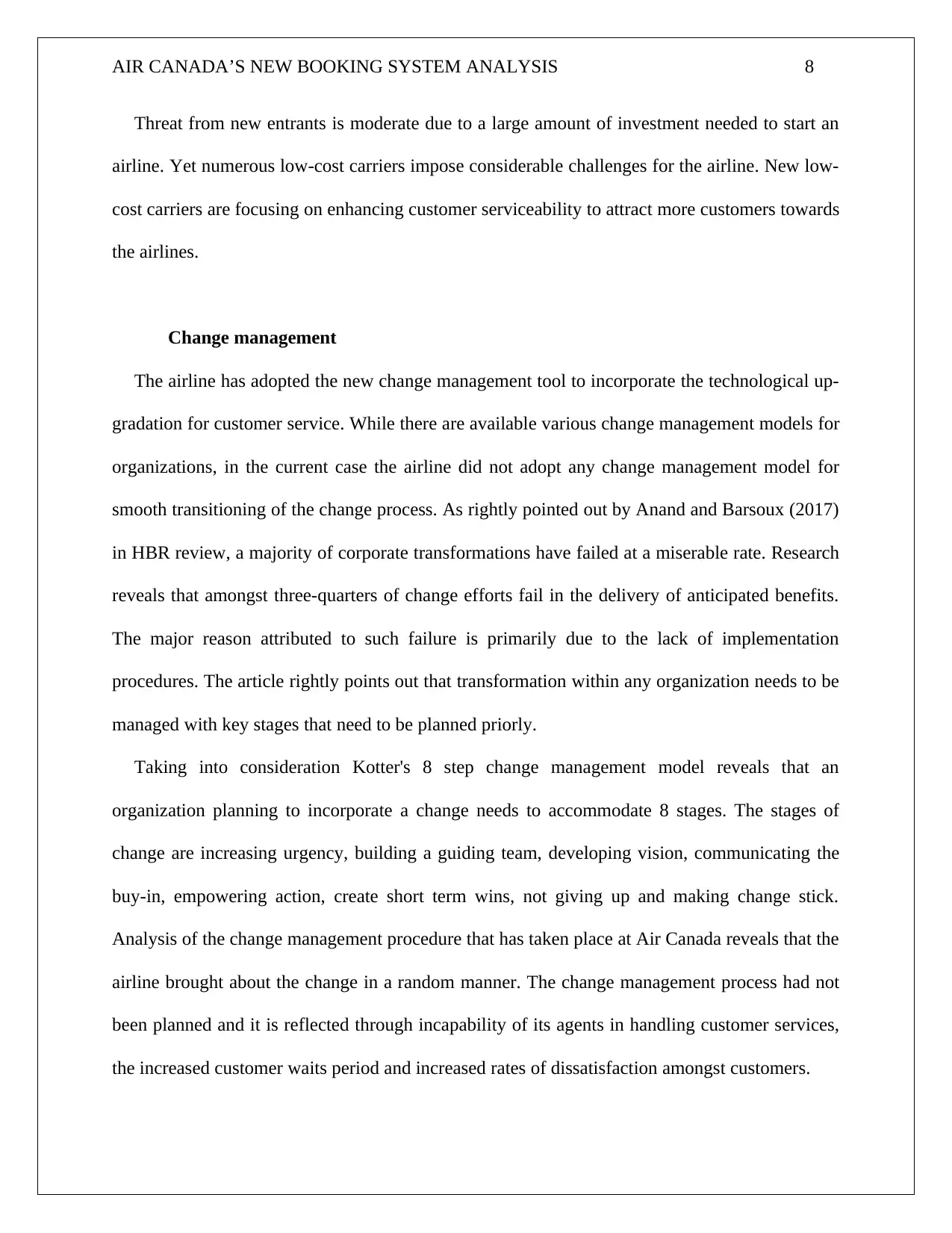
AIR CANADA’S NEW BOOKING SYSTEM ANALYSIS 8
Threat from new entrants is moderate due to a large amount of investment needed to start an
airline. Yet numerous low-cost carriers impose considerable challenges for the airline. New low-
cost carriers are focusing on enhancing customer serviceability to attract more customers towards
the airlines.
Change management
The airline has adopted the new change management tool to incorporate the technological up-
gradation for customer service. While there are available various change management models for
organizations, in the current case the airline did not adopt any change management model for
smooth transitioning of the change process. As rightly pointed out by Anand and Barsoux (2017)
in HBR review, a majority of corporate transformations have failed at a miserable rate. Research
reveals that amongst three-quarters of change efforts fail in the delivery of anticipated benefits.
The major reason attributed to such failure is primarily due to the lack of implementation
procedures. The article rightly points out that transformation within any organization needs to be
managed with key stages that need to be planned priorly.
Taking into consideration Kotter's 8 step change management model reveals that an
organization planning to incorporate a change needs to accommodate 8 stages. The stages of
change are increasing urgency, building a guiding team, developing vision, communicating the
buy-in, empowering action, create short term wins, not giving up and making change stick.
Analysis of the change management procedure that has taken place at Air Canada reveals that the
airline brought about the change in a random manner. The change management process had not
been planned and it is reflected through incapability of its agents in handling customer services,
the increased customer waits period and increased rates of dissatisfaction amongst customers.
Threat from new entrants is moderate due to a large amount of investment needed to start an
airline. Yet numerous low-cost carriers impose considerable challenges for the airline. New low-
cost carriers are focusing on enhancing customer serviceability to attract more customers towards
the airlines.
Change management
The airline has adopted the new change management tool to incorporate the technological up-
gradation for customer service. While there are available various change management models for
organizations, in the current case the airline did not adopt any change management model for
smooth transitioning of the change process. As rightly pointed out by Anand and Barsoux (2017)
in HBR review, a majority of corporate transformations have failed at a miserable rate. Research
reveals that amongst three-quarters of change efforts fail in the delivery of anticipated benefits.
The major reason attributed to such failure is primarily due to the lack of implementation
procedures. The article rightly points out that transformation within any organization needs to be
managed with key stages that need to be planned priorly.
Taking into consideration Kotter's 8 step change management model reveals that an
organization planning to incorporate a change needs to accommodate 8 stages. The stages of
change are increasing urgency, building a guiding team, developing vision, communicating the
buy-in, empowering action, create short term wins, not giving up and making change stick.
Analysis of the change management procedure that has taken place at Air Canada reveals that the
airline brought about the change in a random manner. The change management process had not
been planned and it is reflected through incapability of its agents in handling customer services,
the increased customer waits period and increased rates of dissatisfaction amongst customers.
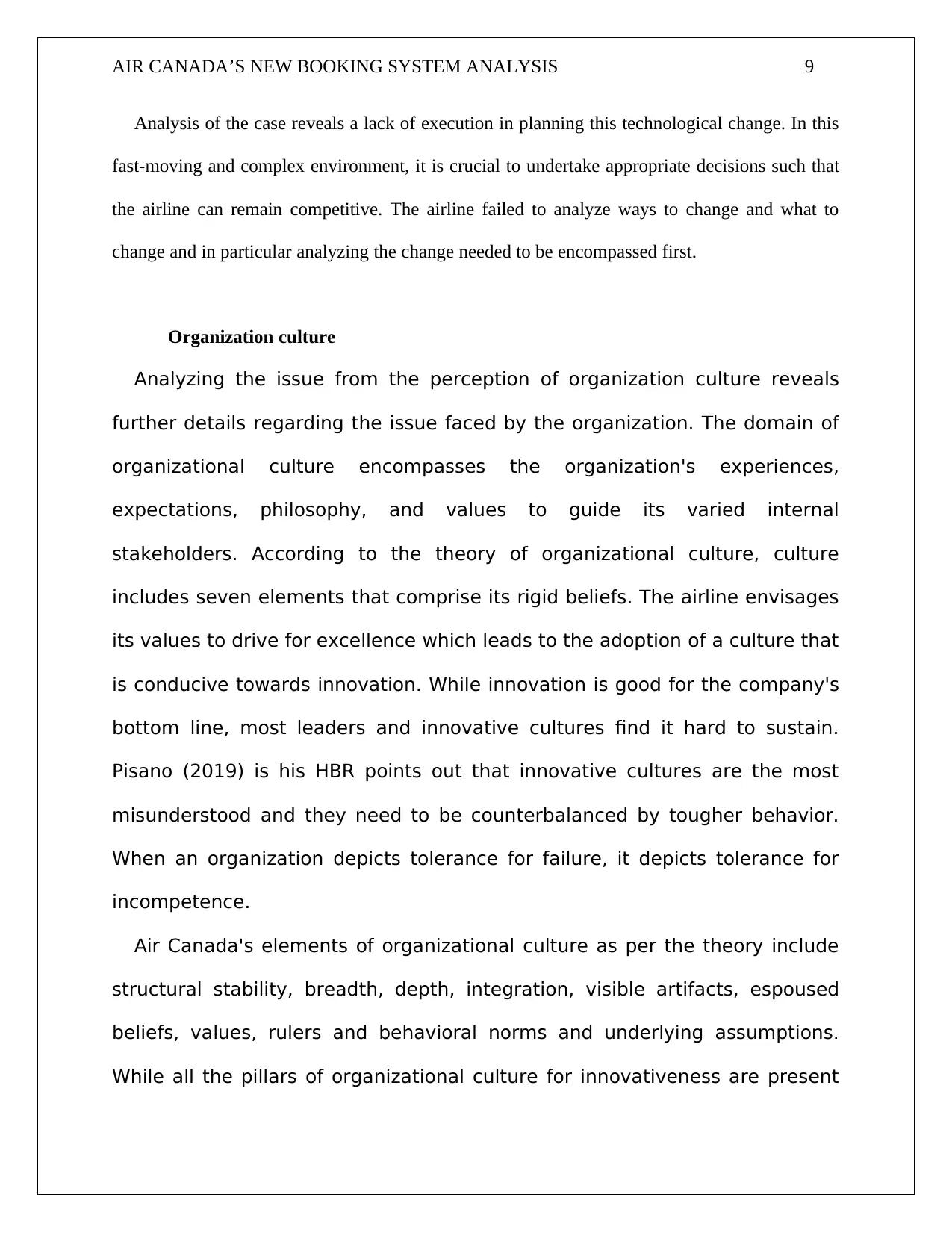
AIR CANADA’S NEW BOOKING SYSTEM ANALYSIS 9
Analysis of the case reveals a lack of execution in planning this technological change. In this
fast-moving and complex environment, it is crucial to undertake appropriate decisions such that
the airline can remain competitive. The airline failed to analyze ways to change and what to
change and in particular analyzing the change needed to be encompassed first.
Organization culture
Analyzing the issue from the perception of organization culture reveals
further details regarding the issue faced by the organization. The domain of
organizational culture encompasses the organization's experiences,
expectations, philosophy, and values to guide its varied internal
stakeholders. According to the theory of organizational culture, culture
includes seven elements that comprise its rigid beliefs. The airline envisages
its values to drive for excellence which leads to the adoption of a culture that
is conducive towards innovation. While innovation is good for the company's
bottom line, most leaders and innovative cultures find it hard to sustain.
Pisano (2019) is his HBR points out that innovative cultures are the most
misunderstood and they need to be counterbalanced by tougher behavior.
When an organization depicts tolerance for failure, it depicts tolerance for
incompetence.
Air Canada's elements of organizational culture as per the theory include
structural stability, breadth, depth, integration, visible artifacts, espoused
beliefs, values, rulers and behavioral norms and underlying assumptions.
While all the pillars of organizational culture for innovativeness are present
Analysis of the case reveals a lack of execution in planning this technological change. In this
fast-moving and complex environment, it is crucial to undertake appropriate decisions such that
the airline can remain competitive. The airline failed to analyze ways to change and what to
change and in particular analyzing the change needed to be encompassed first.
Organization culture
Analyzing the issue from the perception of organization culture reveals
further details regarding the issue faced by the organization. The domain of
organizational culture encompasses the organization's experiences,
expectations, philosophy, and values to guide its varied internal
stakeholders. According to the theory of organizational culture, culture
includes seven elements that comprise its rigid beliefs. The airline envisages
its values to drive for excellence which leads to the adoption of a culture that
is conducive towards innovation. While innovation is good for the company's
bottom line, most leaders and innovative cultures find it hard to sustain.
Pisano (2019) is his HBR points out that innovative cultures are the most
misunderstood and they need to be counterbalanced by tougher behavior.
When an organization depicts tolerance for failure, it depicts tolerance for
incompetence.
Air Canada's elements of organizational culture as per the theory include
structural stability, breadth, depth, integration, visible artifacts, espoused
beliefs, values, rulers and behavioral norms and underlying assumptions.
While all the pillars of organizational culture for innovativeness are present
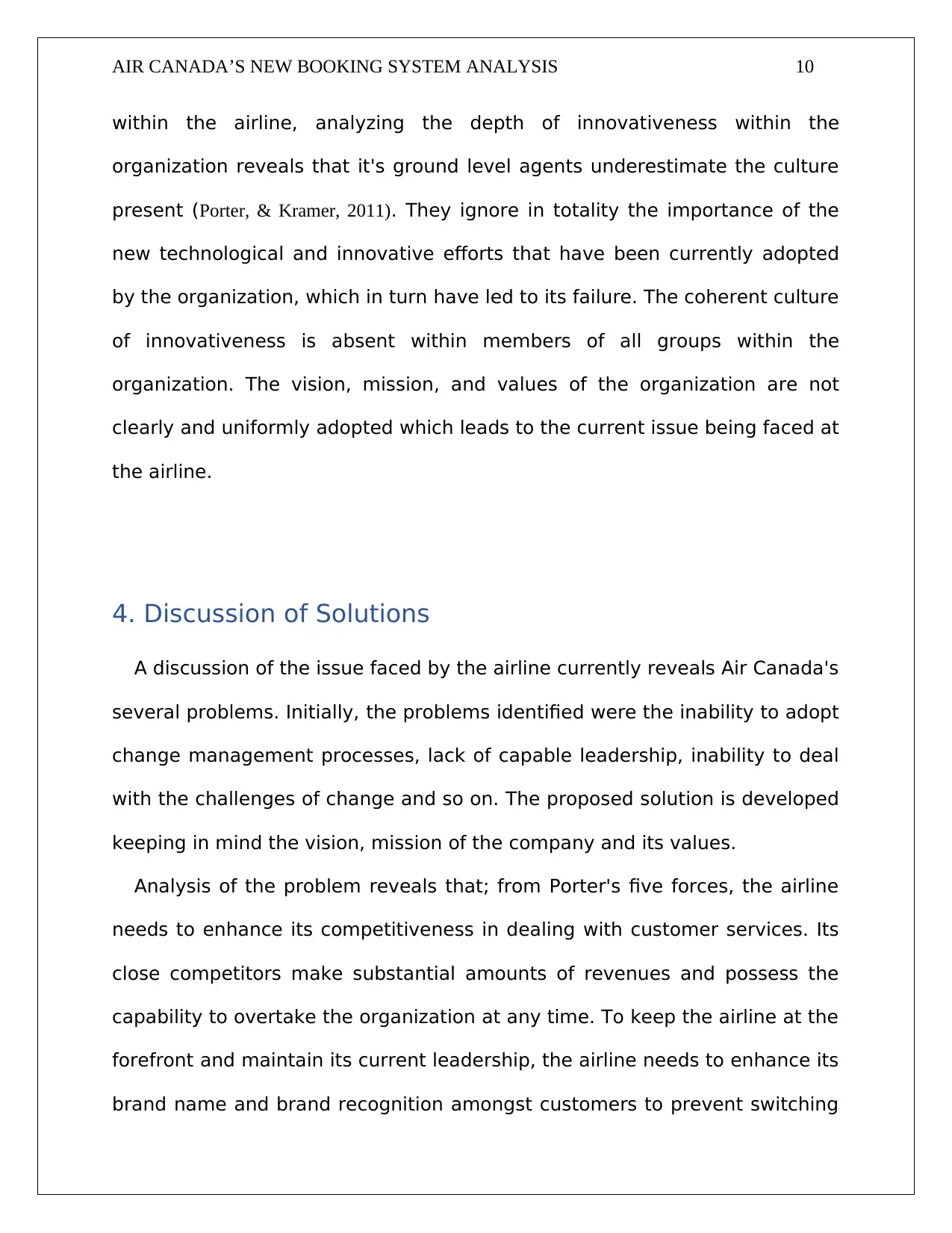
AIR CANADA’S NEW BOOKING SYSTEM ANALYSIS 10
within the airline, analyzing the depth of innovativeness within the
organization reveals that it's ground level agents underestimate the culture
present (Porter, & Kramer, 2011). They ignore in totality the importance of the
new technological and innovative efforts that have been currently adopted
by the organization, which in turn have led to its failure. The coherent culture
of innovativeness is absent within members of all groups within the
organization. The vision, mission, and values of the organization are not
clearly and uniformly adopted which leads to the current issue being faced at
the airline.
4. Discussion of Solutions
A discussion of the issue faced by the airline currently reveals Air Canada's
several problems. Initially, the problems identified were the inability to adopt
change management processes, lack of capable leadership, inability to deal
with the challenges of change and so on. The proposed solution is developed
keeping in mind the vision, mission of the company and its values.
Analysis of the problem reveals that; from Porter's five forces, the airline
needs to enhance its competitiveness in dealing with customer services. Its
close competitors make substantial amounts of revenues and possess the
capability to overtake the organization at any time. To keep the airline at the
forefront and maintain its current leadership, the airline needs to enhance its
brand name and brand recognition amongst customers to prevent switching
within the airline, analyzing the depth of innovativeness within the
organization reveals that it's ground level agents underestimate the culture
present (Porter, & Kramer, 2011). They ignore in totality the importance of the
new technological and innovative efforts that have been currently adopted
by the organization, which in turn have led to its failure. The coherent culture
of innovativeness is absent within members of all groups within the
organization. The vision, mission, and values of the organization are not
clearly and uniformly adopted which leads to the current issue being faced at
the airline.
4. Discussion of Solutions
A discussion of the issue faced by the airline currently reveals Air Canada's
several problems. Initially, the problems identified were the inability to adopt
change management processes, lack of capable leadership, inability to deal
with the challenges of change and so on. The proposed solution is developed
keeping in mind the vision, mission of the company and its values.
Analysis of the problem reveals that; from Porter's five forces, the airline
needs to enhance its competitiveness in dealing with customer services. Its
close competitors make substantial amounts of revenues and possess the
capability to overtake the organization at any time. To keep the airline at the
forefront and maintain its current leadership, the airline needs to enhance its
brand name and brand recognition amongst customers to prevent switching
Secure Best Marks with AI Grader
Need help grading? Try our AI Grader for instant feedback on your assignments.
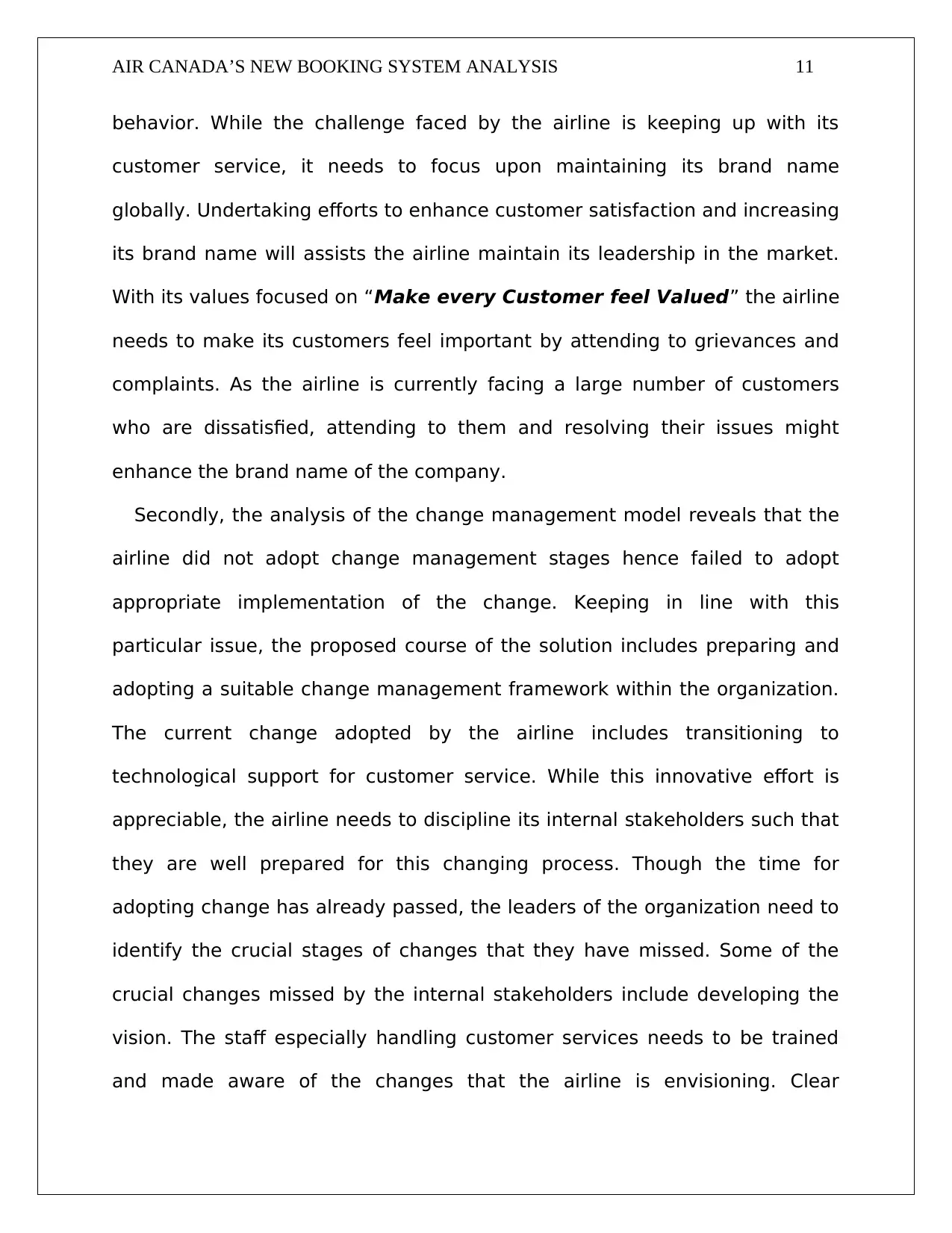
AIR CANADA’S NEW BOOKING SYSTEM ANALYSIS 11
behavior. While the challenge faced by the airline is keeping up with its
customer service, it needs to focus upon maintaining its brand name
globally. Undertaking efforts to enhance customer satisfaction and increasing
its brand name will assists the airline maintain its leadership in the market.
With its values focused on “Make every Customer feel Valued” the airline
needs to make its customers feel important by attending to grievances and
complaints. As the airline is currently facing a large number of customers
who are dissatisfied, attending to them and resolving their issues might
enhance the brand name of the company.
Secondly, the analysis of the change management model reveals that the
airline did not adopt change management stages hence failed to adopt
appropriate implementation of the change. Keeping in line with this
particular issue, the proposed course of the solution includes preparing and
adopting a suitable change management framework within the organization.
The current change adopted by the airline includes transitioning to
technological support for customer service. While this innovative effort is
appreciable, the airline needs to discipline its internal stakeholders such that
they are well prepared for this changing process. Though the time for
adopting change has already passed, the leaders of the organization need to
identify the crucial stages of changes that they have missed. Some of the
crucial changes missed by the internal stakeholders include developing the
vision. The staff especially handling customer services needs to be trained
and made aware of the changes that the airline is envisioning. Clear
behavior. While the challenge faced by the airline is keeping up with its
customer service, it needs to focus upon maintaining its brand name
globally. Undertaking efforts to enhance customer satisfaction and increasing
its brand name will assists the airline maintain its leadership in the market.
With its values focused on “Make every Customer feel Valued” the airline
needs to make its customers feel important by attending to grievances and
complaints. As the airline is currently facing a large number of customers
who are dissatisfied, attending to them and resolving their issues might
enhance the brand name of the company.
Secondly, the analysis of the change management model reveals that the
airline did not adopt change management stages hence failed to adopt
appropriate implementation of the change. Keeping in line with this
particular issue, the proposed course of the solution includes preparing and
adopting a suitable change management framework within the organization.
The current change adopted by the airline includes transitioning to
technological support for customer service. While this innovative effort is
appreciable, the airline needs to discipline its internal stakeholders such that
they are well prepared for this changing process. Though the time for
adopting change has already passed, the leaders of the organization need to
identify the crucial stages of changes that they have missed. Some of the
crucial changes missed by the internal stakeholders include developing the
vision. The staff especially handling customer services needs to be trained
and made aware of the changes that the airline is envisioning. Clear
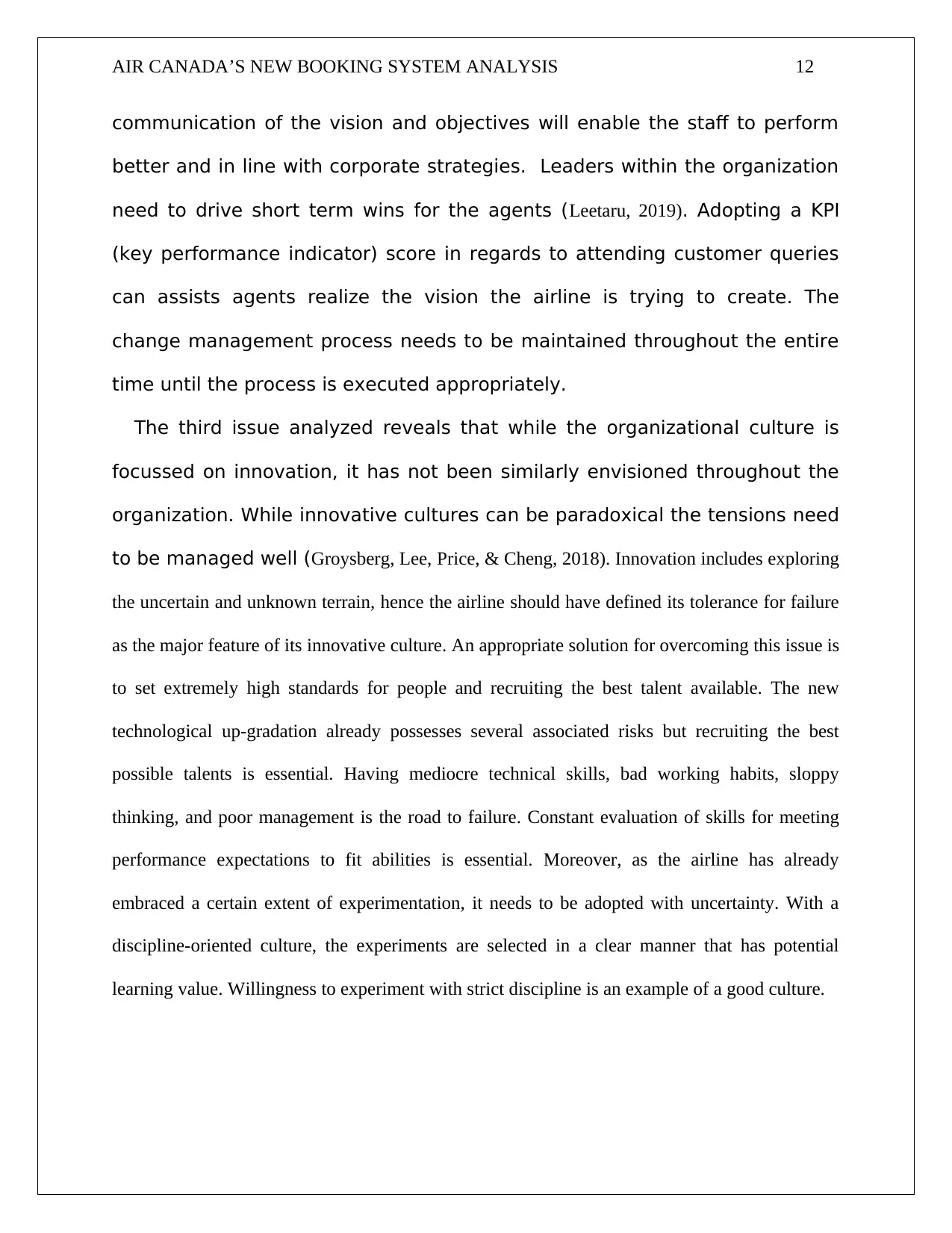
AIR CANADA’S NEW BOOKING SYSTEM ANALYSIS 12
communication of the vision and objectives will enable the staff to perform
better and in line with corporate strategies. Leaders within the organization
need to drive short term wins for the agents (Leetaru, 2019). Adopting a KPI
(key performance indicator) score in regards to attending customer queries
can assists agents realize the vision the airline is trying to create. The
change management process needs to be maintained throughout the entire
time until the process is executed appropriately.
The third issue analyzed reveals that while the organizational culture is
focussed on innovation, it has not been similarly envisioned throughout the
organization. While innovative cultures can be paradoxical the tensions need
to be managed well (Groysberg, Lee, Price, & Cheng, 2018). Innovation includes exploring
the uncertain and unknown terrain, hence the airline should have defined its tolerance for failure
as the major feature of its innovative culture. An appropriate solution for overcoming this issue is
to set extremely high standards for people and recruiting the best talent available. The new
technological up-gradation already possesses several associated risks but recruiting the best
possible talents is essential. Having mediocre technical skills, bad working habits, sloppy
thinking, and poor management is the road to failure. Constant evaluation of skills for meeting
performance expectations to fit abilities is essential. Moreover, as the airline has already
embraced a certain extent of experimentation, it needs to be adopted with uncertainty. With a
discipline-oriented culture, the experiments are selected in a clear manner that has potential
learning value. Willingness to experiment with strict discipline is an example of a good culture.
communication of the vision and objectives will enable the staff to perform
better and in line with corporate strategies. Leaders within the organization
need to drive short term wins for the agents (Leetaru, 2019). Adopting a KPI
(key performance indicator) score in regards to attending customer queries
can assists agents realize the vision the airline is trying to create. The
change management process needs to be maintained throughout the entire
time until the process is executed appropriately.
The third issue analyzed reveals that while the organizational culture is
focussed on innovation, it has not been similarly envisioned throughout the
organization. While innovative cultures can be paradoxical the tensions need
to be managed well (Groysberg, Lee, Price, & Cheng, 2018). Innovation includes exploring
the uncertain and unknown terrain, hence the airline should have defined its tolerance for failure
as the major feature of its innovative culture. An appropriate solution for overcoming this issue is
to set extremely high standards for people and recruiting the best talent available. The new
technological up-gradation already possesses several associated risks but recruiting the best
possible talents is essential. Having mediocre technical skills, bad working habits, sloppy
thinking, and poor management is the road to failure. Constant evaluation of skills for meeting
performance expectations to fit abilities is essential. Moreover, as the airline has already
embraced a certain extent of experimentation, it needs to be adopted with uncertainty. With a
discipline-oriented culture, the experiments are selected in a clear manner that has potential
learning value. Willingness to experiment with strict discipline is an example of a good culture.
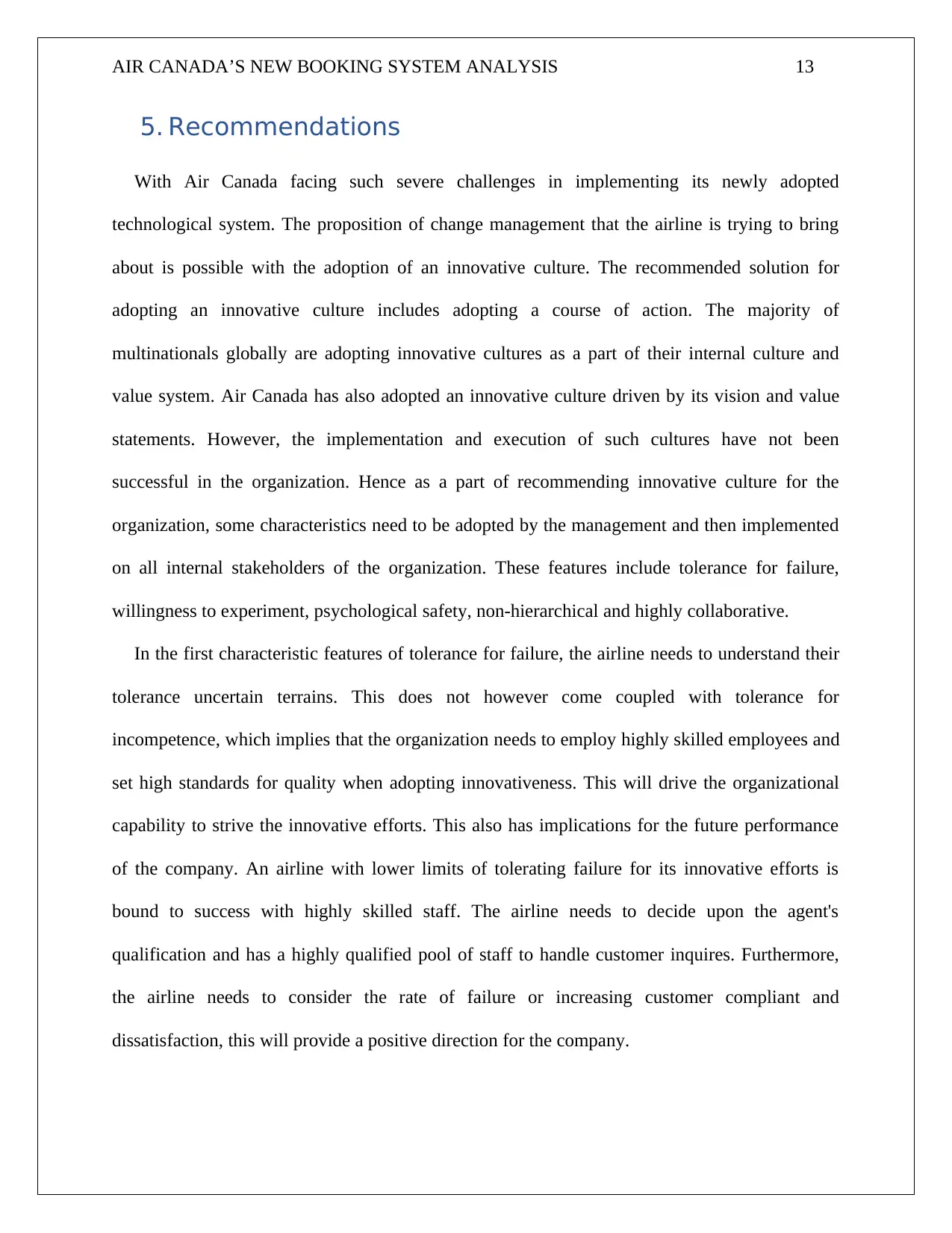
AIR CANADA’S NEW BOOKING SYSTEM ANALYSIS 13
5. Recommendations
With Air Canada facing such severe challenges in implementing its newly adopted
technological system. The proposition of change management that the airline is trying to bring
about is possible with the adoption of an innovative culture. The recommended solution for
adopting an innovative culture includes adopting a course of action. The majority of
multinationals globally are adopting innovative cultures as a part of their internal culture and
value system. Air Canada has also adopted an innovative culture driven by its vision and value
statements. However, the implementation and execution of such cultures have not been
successful in the organization. Hence as a part of recommending innovative culture for the
organization, some characteristics need to be adopted by the management and then implemented
on all internal stakeholders of the organization. These features include tolerance for failure,
willingness to experiment, psychological safety, non-hierarchical and highly collaborative.
In the first characteristic features of tolerance for failure, the airline needs to understand their
tolerance uncertain terrains. This does not however come coupled with tolerance for
incompetence, which implies that the organization needs to employ highly skilled employees and
set high standards for quality when adopting innovativeness. This will drive the organizational
capability to strive the innovative efforts. This also has implications for the future performance
of the company. An airline with lower limits of tolerating failure for its innovative efforts is
bound to success with highly skilled staff. The airline needs to decide upon the agent's
qualification and has a highly qualified pool of staff to handle customer inquires. Furthermore,
the airline needs to consider the rate of failure or increasing customer compliant and
dissatisfaction, this will provide a positive direction for the company.
5. Recommendations
With Air Canada facing such severe challenges in implementing its newly adopted
technological system. The proposition of change management that the airline is trying to bring
about is possible with the adoption of an innovative culture. The recommended solution for
adopting an innovative culture includes adopting a course of action. The majority of
multinationals globally are adopting innovative cultures as a part of their internal culture and
value system. Air Canada has also adopted an innovative culture driven by its vision and value
statements. However, the implementation and execution of such cultures have not been
successful in the organization. Hence as a part of recommending innovative culture for the
organization, some characteristics need to be adopted by the management and then implemented
on all internal stakeholders of the organization. These features include tolerance for failure,
willingness to experiment, psychological safety, non-hierarchical and highly collaborative.
In the first characteristic features of tolerance for failure, the airline needs to understand their
tolerance uncertain terrains. This does not however come coupled with tolerance for
incompetence, which implies that the organization needs to employ highly skilled employees and
set high standards for quality when adopting innovativeness. This will drive the organizational
capability to strive the innovative efforts. This also has implications for the future performance
of the company. An airline with lower limits of tolerating failure for its innovative efforts is
bound to success with highly skilled staff. The airline needs to decide upon the agent's
qualification and has a highly qualified pool of staff to handle customer inquires. Furthermore,
the airline needs to consider the rate of failure or increasing customer compliant and
dissatisfaction, this will provide a positive direction for the company.
Paraphrase This Document
Need a fresh take? Get an instant paraphrase of this document with our AI Paraphraser
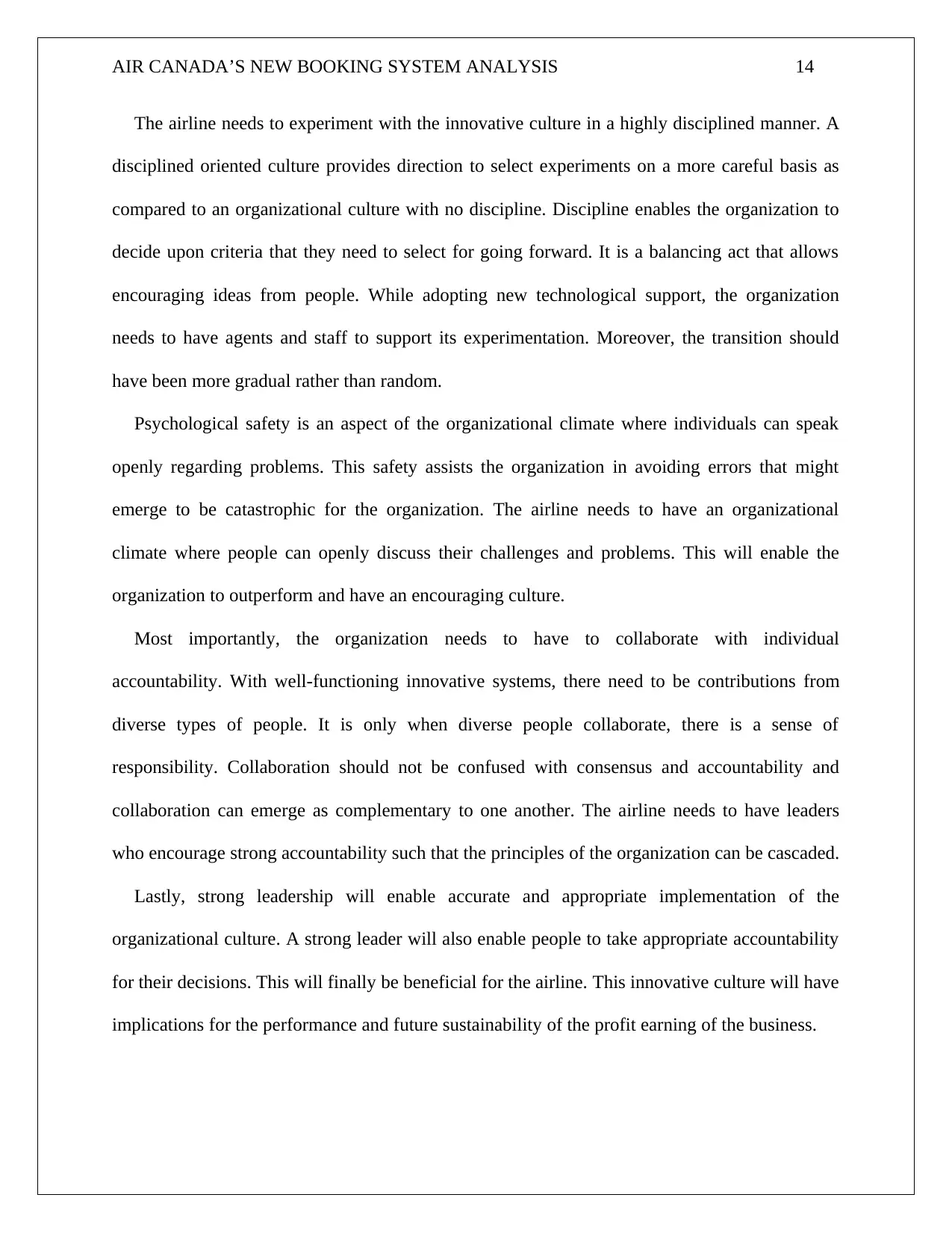
AIR CANADA’S NEW BOOKING SYSTEM ANALYSIS 14
The airline needs to experiment with the innovative culture in a highly disciplined manner. A
disciplined oriented culture provides direction to select experiments on a more careful basis as
compared to an organizational culture with no discipline. Discipline enables the organization to
decide upon criteria that they need to select for going forward. It is a balancing act that allows
encouraging ideas from people. While adopting new technological support, the organization
needs to have agents and staff to support its experimentation. Moreover, the transition should
have been more gradual rather than random.
Psychological safety is an aspect of the organizational climate where individuals can speak
openly regarding problems. This safety assists the organization in avoiding errors that might
emerge to be catastrophic for the organization. The airline needs to have an organizational
climate where people can openly discuss their challenges and problems. This will enable the
organization to outperform and have an encouraging culture.
Most importantly, the organization needs to have to collaborate with individual
accountability. With well-functioning innovative systems, there need to be contributions from
diverse types of people. It is only when diverse people collaborate, there is a sense of
responsibility. Collaboration should not be confused with consensus and accountability and
collaboration can emerge as complementary to one another. The airline needs to have leaders
who encourage strong accountability such that the principles of the organization can be cascaded.
Lastly, strong leadership will enable accurate and appropriate implementation of the
organizational culture. A strong leader will also enable people to take appropriate accountability
for their decisions. This will finally be beneficial for the airline. This innovative culture will have
implications for the performance and future sustainability of the profit earning of the business.
The airline needs to experiment with the innovative culture in a highly disciplined manner. A
disciplined oriented culture provides direction to select experiments on a more careful basis as
compared to an organizational culture with no discipline. Discipline enables the organization to
decide upon criteria that they need to select for going forward. It is a balancing act that allows
encouraging ideas from people. While adopting new technological support, the organization
needs to have agents and staff to support its experimentation. Moreover, the transition should
have been more gradual rather than random.
Psychological safety is an aspect of the organizational climate where individuals can speak
openly regarding problems. This safety assists the organization in avoiding errors that might
emerge to be catastrophic for the organization. The airline needs to have an organizational
climate where people can openly discuss their challenges and problems. This will enable the
organization to outperform and have an encouraging culture.
Most importantly, the organization needs to have to collaborate with individual
accountability. With well-functioning innovative systems, there need to be contributions from
diverse types of people. It is only when diverse people collaborate, there is a sense of
responsibility. Collaboration should not be confused with consensus and accountability and
collaboration can emerge as complementary to one another. The airline needs to have leaders
who encourage strong accountability such that the principles of the organization can be cascaded.
Lastly, strong leadership will enable accurate and appropriate implementation of the
organizational culture. A strong leader will also enable people to take appropriate accountability
for their decisions. This will finally be beneficial for the airline. This innovative culture will have
implications for the performance and future sustainability of the profit earning of the business.
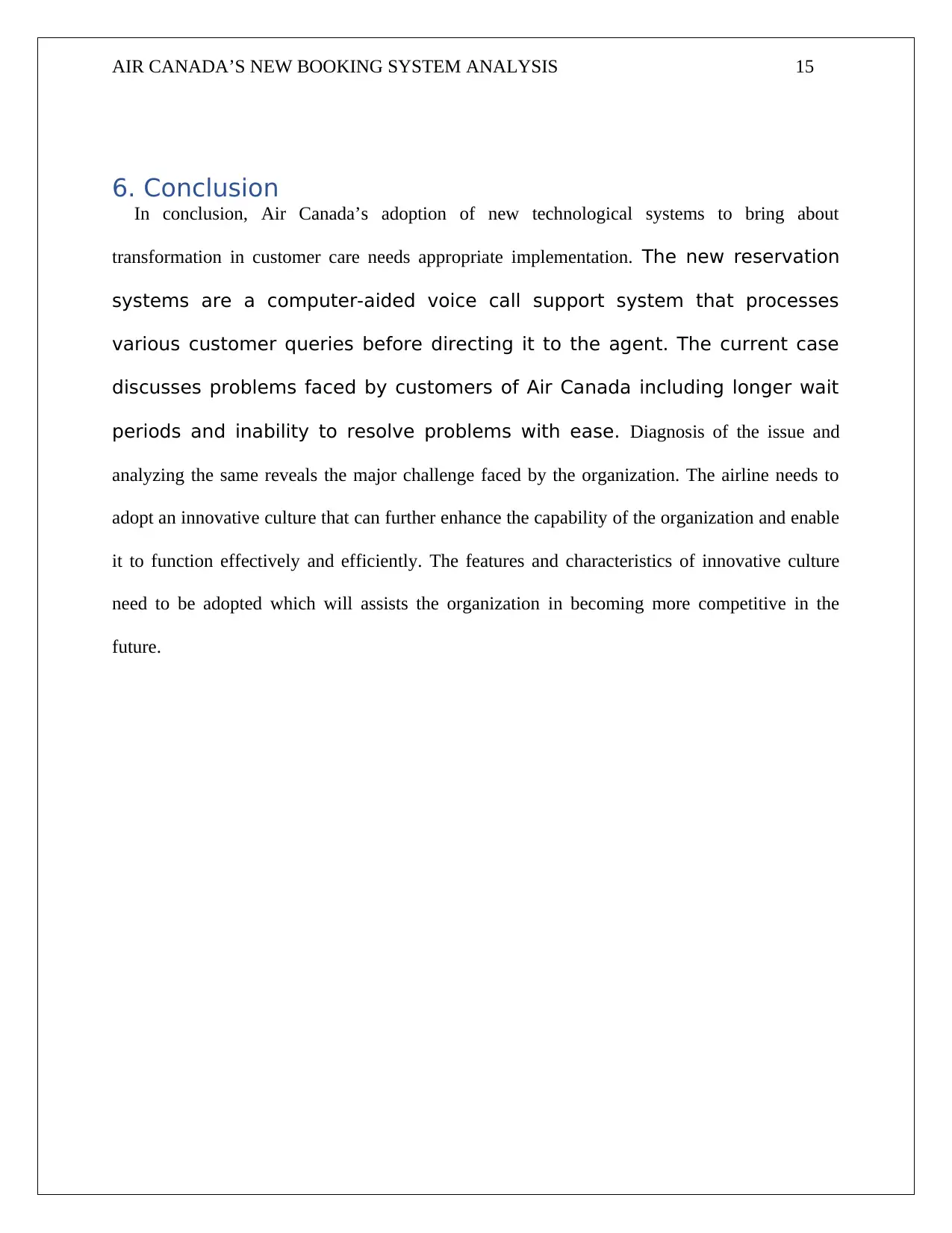
AIR CANADA’S NEW BOOKING SYSTEM ANALYSIS 15
6. Conclusion
In conclusion, Air Canada’s adoption of new technological systems to bring about
transformation in customer care needs appropriate implementation. The new reservation
systems are a computer-aided voice call support system that processes
various customer queries before directing it to the agent. The current case
discusses problems faced by customers of Air Canada including longer wait
periods and inability to resolve problems with ease. Diagnosis of the issue and
analyzing the same reveals the major challenge faced by the organization. The airline needs to
adopt an innovative culture that can further enhance the capability of the organization and enable
it to function effectively and efficiently. The features and characteristics of innovative culture
need to be adopted which will assists the organization in becoming more competitive in the
future.
6. Conclusion
In conclusion, Air Canada’s adoption of new technological systems to bring about
transformation in customer care needs appropriate implementation. The new reservation
systems are a computer-aided voice call support system that processes
various customer queries before directing it to the agent. The current case
discusses problems faced by customers of Air Canada including longer wait
periods and inability to resolve problems with ease. Diagnosis of the issue and
analyzing the same reveals the major challenge faced by the organization. The airline needs to
adopt an innovative culture that can further enhance the capability of the organization and enable
it to function effectively and efficiently. The features and characteristics of innovative culture
need to be adopted which will assists the organization in becoming more competitive in the
future.
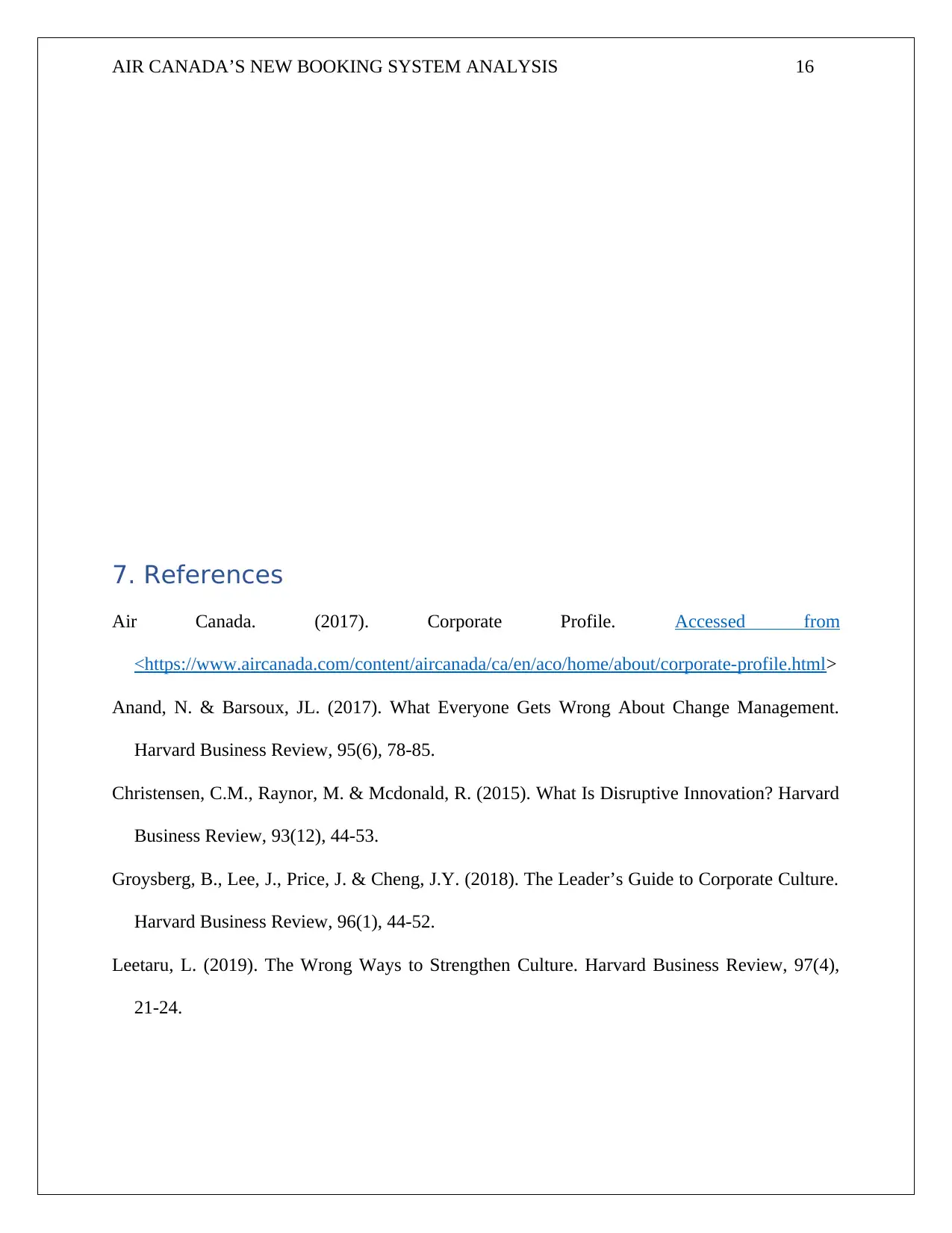
AIR CANADA’S NEW BOOKING SYSTEM ANALYSIS 16
7. References
Air Canada. (2017). Corporate Profile. Accessed from
<https://www.aircanada.com/content/aircanada/ca/en/aco/home/about/corporate-profile.html>
Anand, N. & Barsoux, JL. (2017). What Everyone Gets Wrong About Change Management.
Harvard Business Review, 95(6), 78-85.
Christensen, C.M., Raynor, M. & Mcdonald, R. (2015). What Is Disruptive Innovation? Harvard
Business Review, 93(12), 44-53.
Groysberg, B., Lee, J., Price, J. & Cheng, J.Y. (2018). The Leader’s Guide to Corporate Culture.
Harvard Business Review, 96(1), 44-52.
Leetaru, L. (2019). The Wrong Ways to Strengthen Culture. Harvard Business Review, 97(4),
21-24.
7. References
Air Canada. (2017). Corporate Profile. Accessed from
<https://www.aircanada.com/content/aircanada/ca/en/aco/home/about/corporate-profile.html>
Anand, N. & Barsoux, JL. (2017). What Everyone Gets Wrong About Change Management.
Harvard Business Review, 95(6), 78-85.
Christensen, C.M., Raynor, M. & Mcdonald, R. (2015). What Is Disruptive Innovation? Harvard
Business Review, 93(12), 44-53.
Groysberg, B., Lee, J., Price, J. & Cheng, J.Y. (2018). The Leader’s Guide to Corporate Culture.
Harvard Business Review, 96(1), 44-52.
Leetaru, L. (2019). The Wrong Ways to Strengthen Culture. Harvard Business Review, 97(4),
21-24.
Secure Best Marks with AI Grader
Need help grading? Try our AI Grader for instant feedback on your assignments.
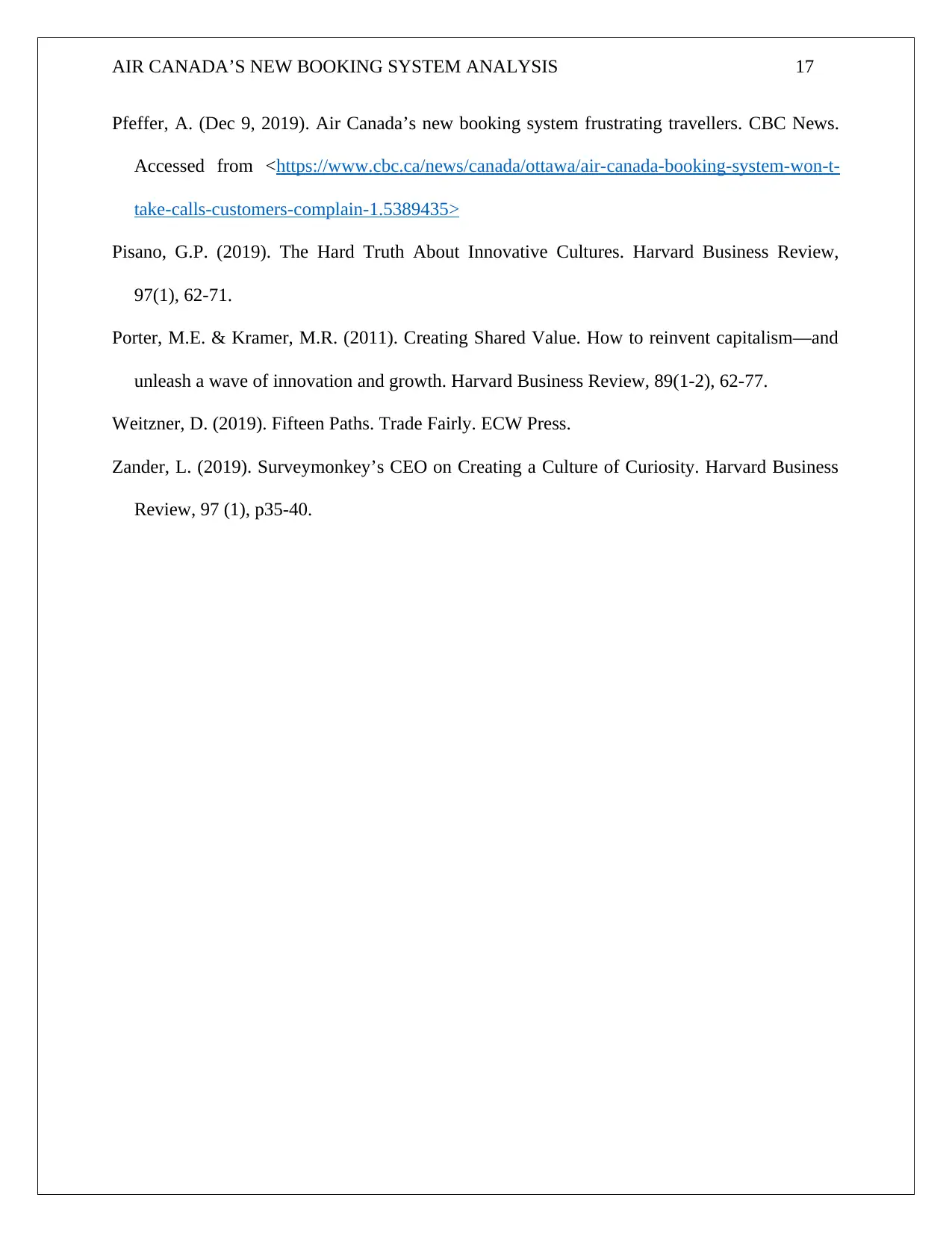
AIR CANADA’S NEW BOOKING SYSTEM ANALYSIS 17
Pfeffer, A. (Dec 9, 2019). Air Canada’s new booking system frustrating travellers. CBC News.
Accessed from <https://www.cbc.ca/news/canada/ottawa/air-canada-booking-system-won-t-
take-calls-customers-complain-1.5389435>
Pisano, G.P. (2019). The Hard Truth About Innovative Cultures. Harvard Business Review,
97(1), 62-71.
Porter, M.E. & Kramer, M.R. (2011). Creating Shared Value. How to reinvent capitalism—and
unleash a wave of innovation and growth. Harvard Business Review, 89(1-2), 62-77.
Weitzner, D. (2019). Fifteen Paths. Trade Fairly. ECW Press.
Zander, L. (2019). Surveymonkey’s CEO on Creating a Culture of Curiosity. Harvard Business
Review, 97 (1), p35-40.
Pfeffer, A. (Dec 9, 2019). Air Canada’s new booking system frustrating travellers. CBC News.
Accessed from <https://www.cbc.ca/news/canada/ottawa/air-canada-booking-system-won-t-
take-calls-customers-complain-1.5389435>
Pisano, G.P. (2019). The Hard Truth About Innovative Cultures. Harvard Business Review,
97(1), 62-71.
Porter, M.E. & Kramer, M.R. (2011). Creating Shared Value. How to reinvent capitalism—and
unleash a wave of innovation and growth. Harvard Business Review, 89(1-2), 62-77.
Weitzner, D. (2019). Fifteen Paths. Trade Fairly. ECW Press.
Zander, L. (2019). Surveymonkey’s CEO on Creating a Culture of Curiosity. Harvard Business
Review, 97 (1), p35-40.
1 out of 17
Related Documents
Your All-in-One AI-Powered Toolkit for Academic Success.
+13062052269
info@desklib.com
Available 24*7 on WhatsApp / Email
![[object Object]](/_next/static/media/star-bottom.7253800d.svg)
Unlock your academic potential
© 2024 | Zucol Services PVT LTD | All rights reserved.





